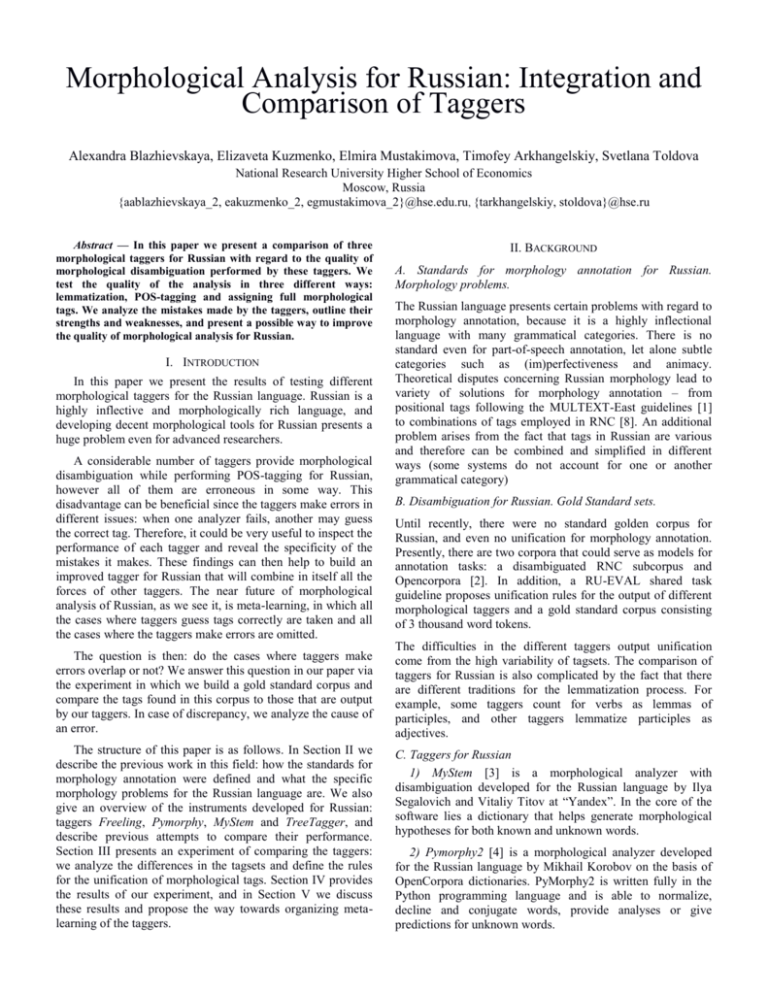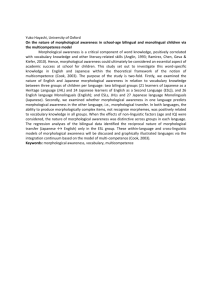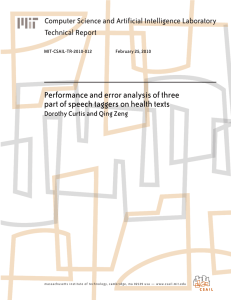comparing taggers for Russian
advertisement

Morphological Analysis for Russian: Integration and
Comparison of Taggers
Alexandra Blazhievskaya, Elizaveta Kuzmenko, Elmira Mustakimova, Timofey Arkhangelskiy, Svetlana Toldova
National Research University Higher School of Economics
Moscow, Russia
{aablazhievskaya_2, eakuzmenko_2, egmustakimova_2}@hse.edu.ru, {tarkhangelskiy, stoldova}@hse.ru
Abstract — In this paper we present a comparison of three
morphological taggers for Russian with regard to the quality of
morphological disambiguation performed by these taggers. We
test the quality of the analysis in three different ways:
lemmatization, POS-tagging and assigning full morphological
tags. We analyze the mistakes made by the taggers, outline their
strengths and weaknesses, and present a possible way to improve
the quality of morphological analysis for Russian.
I. INTRODUCTION
In this paper we present the results of testing different
morphological taggers for the Russian language. Russian is a
highly inflective and morphologically rich language, and
developing decent morphological tools for Russian presents a
huge problem even for advanced researchers.
A considerable number of taggers provide morphological
disambiguation while performing POS-tagging for Russian,
however all of them are erroneous in some way. This
disadvantage can be beneficial since the taggers make errors in
different issues: when one analyzer fails, another may guess
the correct tag. Therefore, it could be very useful to inspect the
performance of each tagger and reveal the specificity of the
mistakes it makes. These findings can then help to build an
improved tagger for Russian that will combine in itself all the
forces of other taggers. The near future of morphological
analysis of Russian, as we see it, is meta-learning, in which all
the cases where taggers guess tags correctly are taken and all
the cases where the taggers make errors are omitted.
The question is then: do the cases where taggers make
errors overlap or not? We answer this question in our paper via
the experiment in which we build a gold standard corpus and
compare the tags found in this corpus to those that are output
by our taggers. In case of discrepancy, we analyze the cause of
an error.
The structure of this paper is as follows. In Section II we
describe the previous work in this field: how the standards for
morphology annotation were defined and what the specific
morphology problems for the Russian language are. We also
give an overview of the instruments developed for Russian:
taggers Freeling, Pymorphy, MyStem and TreeTagger, and
describe previous attempts to compare their performance.
Section III presents an experiment of comparing the taggers:
we analyze the differences in the tagsets and define the rules
for the unification of morphological tags. Section IV provides
the results of our experiment, and in Section V we discuss
these results and propose the way towards organizing metalearning of the taggers.
II. BACKGROUND
A. Standards for morphology annotation for Russian.
Morphology problems.
The Russian language presents certain problems with regard to
morphology annotation, because it is a highly inflectional
language with many grammatical categories. There is no
standard even for part-of-speech annotation, let alone subtle
categories such as (im)perfectiveness and animacy.
Theoretical disputes concerning Russian morphology lead to
variety of solutions for morphology annotation – from
positional tags following the MULTEXT-East guidelines [1]
to combinations of tags employed in RNC [8]. An additional
problem arises from the fact that tags in Russian are various
and therefore can be combined and simplified in different
ways (some systems do not account for one or another
grammatical category)
B. Disambiguation for Russian. Gold Standard sets.
Until recently, there were no standard golden corpus for
Russian, and even no unification for morphology annotation.
Presently, there are two corpora that could serve as models for
annotation tasks: a disambiguated RNC subcorpus and
Opencorpora [2]. In addition, a RU-EVAL shared task
guideline proposes unification rules for the output of different
morphological taggers and a gold standard corpus consisting
of 3 thousand word tokens.
The difficulties in the different taggers output unification
come from the high variability of tagsets. The comparison of
taggers for Russian is also complicated by the fact that there
are different traditions for the lemmatization process. For
example, some taggers count for verbs as lemmas of
participles, and other taggers lemmatize participles as
adjectives.
C. Taggers for Russian
1) MyStem [3] is a morphological analyzer with
disambiguation developed for the Russian language by Ilya
Segalovich and Vitaliy Titov at “Yandex”. In the core of the
software lies a dictionary that helps generate morphological
hypotheses for both known and unknown words.
2) Pymorphy2 [4] is a morphological analyzer developed
for the Russian language by Mikhail Korobov on the basis of
OpenCorpora dictionaries. PyMorphy2 is written fully in the
Python programming language and is able to normalize,
decline and conjugate words, provide analyses or give
predictions for unknown words.
3) Freeling [5] is a set of open source linguistic analyzers
for several languages. It features tokenizing, sentence splitting,
morphology analyzers with disambiguation, syntax parsing,
named entity recognition, etc. In this research, we use only
morphological analyzer for Russian.
4) TreeTagger [6, 7] is a language independent part-ofspeech tagger developed by Helmut Schmid. TreeTagger is
based on decision trees and should be trained on a lexicon and
a manually tagged training corpus. The program can annotate
texts with part-of-speech and lemma information.
III. EXPERIMENT DESIGN
In the experiment we evaluated the performance of our
taggers compared to the gold standard corpus.
As a gold standard we took a part of a disambiguated
subcorpus of Russian National Corpus [8]. This subcorpus
contains 5.9 million tokens, annotated morphologically with
the help of MyStem and disambiguated by hand. Therefore, the
tokens have only one morphological analysis, and the tagset in
this corpus complies to the one developed for MyStem. We
took randomly a 1/20 part of this corpus, containing 426
thousand tokens to serve as a training set.
One of the problems in our experiment is that all analyzers
have different notations for parts of speech and morphological
categories. The discrepancies between the tagsets can be of
different kinds:
Some morphological category is present in the tagset of
the gold standard but absent in the tagset of another
morphological analyzer: for example, MyStem
distinguishes between animate and inanimate nouns or
adjectives as it has specific dictionaries where these
characteristics are defined for every word. TreeTagger,
however, does not consider this feature to be important
for morphology and does not include it in the analysis.
Morphological analyzers have different standards
concerning part of speech identification: for example,
Freeling identifies participles as a separate part of
speech, whereas other morphological analyzers identify
participles as verbal forms.
Consequently, alongside with different standards
towards part of speech identification, parsers assign
different lemmas to tokens problematic in this aspect:
therefore, the lemma for the word ‘сделанной’
(participle) would be ‘сделанный’ (participle) in
Freeling and ‘сделать’ (verb) in MyStem.
If all the taggers provide the same part of speech for a
particular word, there still can be problems with
lemmatization: for example, TreeTagger assigns one
and the same aspect to Russian verbs in different
aspects, and so does Freeling, but other tagsets do not
require the aspect to be changed in the process of
lemmatization.
Due to these problems, we need to define conventions that
will enable us to compare the taggers’ output. Since our gold
standard is annotated by MyStem, we decided to convert the
tags of all analyzers into MyStem–styled tags. The rules of
conversion are presented in Table 1.
TABLE I. RULES FOR CONVERSION OF ALL TAGS INTO MYSTEM-STYLED
TAGSET
Gold standard tag
A-NUM (numeric adj.)
PARENTH(parenthesis)
ADV-PRO (adv.-pronoun)
A-PRO (adj.-pronoun)
m-f (common gender)
anim (animacy)
inan (inanimateness)
dat2 (the 2nd dative)
gen2 (the 2nd genitive)
acc2 (the 2nd accusative)
loc2 (the 2nd locative)
adnum (count form)
intr (intransitiveness)
tran (transitiveness)
Tag counted as correct
NUM (numeral)
ADV(adverb)
PRO (pronoun)
PRO (pronoun)
both are correct
not important
not important
dat (dative)
gen (genitive)
acc (accusative)
loc (locative)
NUM (numeral)
not important
not important
However, Table 1 contains rules only for the least
problematic cases. More problematic cases include, as it was
mentioned earlier, lemmatization of participles and perfective
verbs. These issues we solve by assigning lemmas given by
Mystem and taking the tag itself from another analyzer. In
addition, we do not consider identifying patronyms, zoonyms
and other lexical classes to be of importance for the task of
morphological analysis and exclude them from our
experiment.
IV. EVALUATION
Before evaluation the gold standard text was analyzed by
the three taggers. Their outputs were converted into a single
tagset as described in the previous section. After such
preprocessing, we could start evaluating the analyses.
For each word we compared the analyses of the three
taggers and the analysis presented in the gold standard. In
particular, we checked whether the part of speech was the
same and if the set of grammatical categories contained in the
tag was identical to the gold standard. There were three major
modes of evaluation:
1) checking the correspondence between the assigned
lemmas;
2) checking the correspondence between the assigned parts
of speech;
3) checking the correspondence between the assigned
morphological tags in the whole.
Table 2 presents the results for all our taggers and three
modes.
TABLE II. RESULTS OF THE COMPARISON
Tagger
Freeling
Pymorphy2
TreeTagger
Mode
Lemma
POS
Full tag
Lemma
POS
Full tag
Lemma
POS
Full tag
Precision
81.98%
91.19%
81.31%
87.8%
90.5%
59.2%
97%
95%
91%
Recall
100%
98.76%
100%
100%
99.3%
100%
93%
97%
98%
F1
0.902
0.948
0.897
0,95
0.947
0.743
0.950
0.960
0.944
As it is shown in Table 2, all the taggers present decent
results, but none of them performs without mistakes. The best
results are received for the TreeTagger. Pymorphy2 also
presents high precision and recall for all modes except
complete tags.
V. CONCLUSION
In this paper we presented an analysis of the performance
of three taggers for Russian. The received results are of
interest to anyone engaged in morphological analysis of
Russian. As a future step we plan to build a meta-learning
system based on several taggers. Such system will take as
input the morphological analyses from several taggers,
identify which tagger provides the best guess for each
particular case, and give as output the combination of correct
variants. We expect this system to be highly accurate.
REFERENCES
[1] Erjavec, T. (2004, May). MULTEXT-East Version 3: Multilingual
Morphosyntactic Specifications, Lexicons and Corpora. In LREC.
[2] Bocharov, V., Bichineva, S., Granovsky, D., Ostapuk, N., &
Stepanova, M. (2011). Quality assurance tools in the OpenCorpora
project. In Computational Linguistics and Intelligent Technology:
Proceeding of the International Conference «Dialog (pp. 10-17).
[3] MyStem, Web: https://tech.yandex.ru/mystem/.
[4] PyMorphy2, Web: https://pymorphy2.readthedocs.org/en/latest/.
[5] Padró, L., & Stanilovsky, E. (2012). Freeling 3.0: Towards wider
multilinguality.
[6] H. Schmid, “Improvements in Part-of-Speech Tagging with an
Application to German”, Proceedings of the ACL SIGDATWorkshop. 1995.
[7] H. Schmid, “Probabilistic Part-of-Speech tagging using decision
trees”, Proceedings of International Conference on New Methods in
Language Processing. 1994.
[8] Russian National Corpus, Web: http://ruscorpora.ru/en/.






